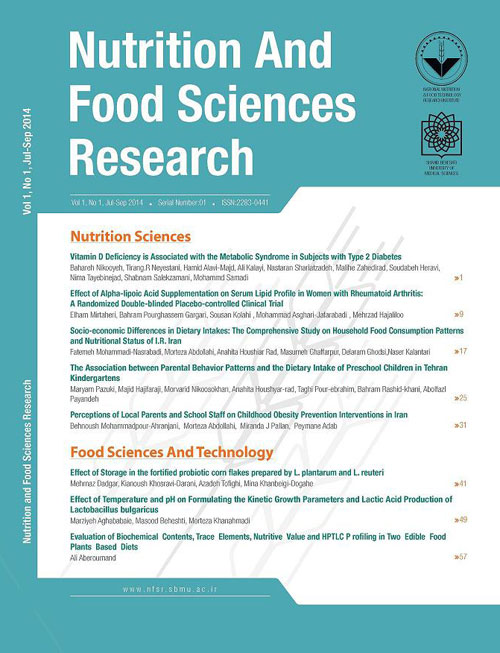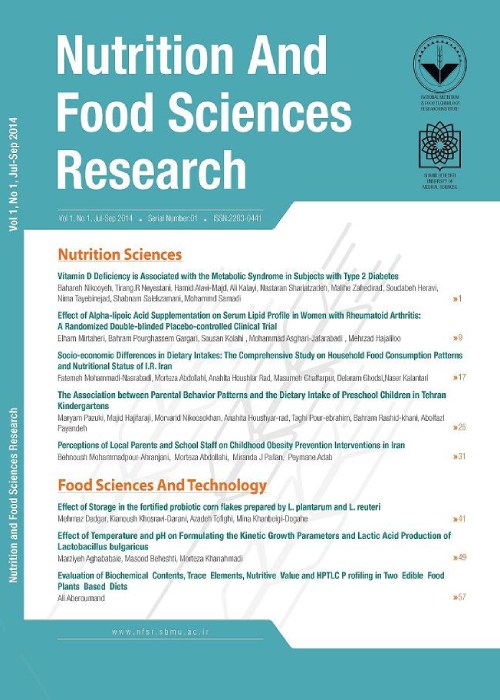فهرست مطالب

Nutrition & Food Technology Research
Volume:5 Issue: 3, Jul-Sep 2018
- تاریخ انتشار: 1397/05/30
- تعداد عناوین: 6
-
-
Pages 1-2in the past 40 years there has been drastic increase in the prevalence of obesity worldwide (1). This rapid increase in the prevalence of obesity is not a matter of physiologic or metabolic alteration within people. Thousands of scientific papers are published each year indicating that pharmaceutical companies are working to find possible money making antiobesity agents. Increasing in the prevalence of obesity across all age groups, ethnicity and socioeconomic levels shows that factors outside of individuals need to be considered (2). Indeed remarkable changes in the food environment have increased access to foods (3). Portion size of food has increased and variety of foods available in marketplaces has been greatly changed (4) and the food industries introduce hundreds of new products each year and they use various techniques to influence consumer behaviour (2).Keywords: Eating Behaviour
-
Pages 3-10Background And ObjectivesVitamin D deficiency during pregnancy is prevalent throughout the world and has been associated with complications in mothers and infants. The aim of this study is to evaluate the efficacy of two doses of vitamin D supplementation (1000 IU/d versus 2000 IU/d) during pregnancy on maternal and cord blood vitamin D status, metabolic, inflammatory and oxidative stress biomarkers as well as maternal and neonatal outcomes (birth size and Apgar score).MethodsA total of 84 pregnant women with the eligible criteria are randomly allocated to one of the two supplementation groups: (a) 1000 IU/d vitamin D which is routinely given to pregnant women, and (b) 2000 IU/d. Biochemical assessments of mothers are performed at the beginning and 34 weeks of gestation. They include serum concentrations of 25-hydroxycalciferol (25(OH)D), calcium, phosphate, intact parathyroid hormone (iPTH), fasting serum glucose (FSG), insulin, lipid profile including triglycerides (TG), total cholesterol (TC), low-density lipoprotein-cholesterol (LDL-C) and high-density lipoprotein cholesterol (HDL_C), as well as high sensitivity C-reactive protein (hs-CRP) and the maternal cell-culture supernatant concentrations of inflammatory cytokines IL-1β, IL-6 and TNF-α. Assessments of infants at delivery comprise cord blood serum concentrations of 25(OH)D, iPTH, hs-CRP, IL-1β, IL-6, TNF-α birth sizes and Apgar score.DiscussionThe results obtained from the clinical efficacy trials on the appropriate dose for vitamin D supplementation during pregnancy are controversial. The current study could be a step to attenuate the existent controversy on evaluating the efficacy of two doses of vitamin D supplement on a wide spectrum of both mother and newborn outcomes. Meanwhile our study could give a clue to the policy-makers at MOH by revealing the efficacy of currently prescribed 1000 IU/d vitaminD3 versus 2000 IU/d.Keywords: Vitamin D supplementation_Clinical efficacy trial_Pregnancy_Study protocol
-
Pages 11-16Background And ObjectivesAlthough the anti-inflammatory effects of phytochemicals have been supported by several in vitro studies, their biological actions from regular diets are mixed. This study aimed to use dietary phytochemical index (DPI), as a food-based framework to assess dietary phytochemical intake and to understand its association with hs-CRP in a sample of Iranian women. Evaluation of the relationship between hs-CRP and several anthropometric indexes were also assessed.Materials And MethodsA total of 170 visibly healthy premenopausal women with the mean age of 35.2 were selected from health centers of Tehran via multistage cluster random sampling. The usual dietary intakes were assessed using a semi-quantitative food frequency questionnaire and dietary phytochemical intake was determined. General linear model was used to compare hs-CRP levels between tertile of DPI. Spearman correlation was used to assess the relationship between hs-CRP and the obesity indexes.ResultsThe mean of DPI was 28.54. Significant spearman correlation coefficients were found between hs-CRP and WC (0.43), BMI (0.35), Waist to hip ratio (0.30), visceral adiposity index (0.28) (spearmans coefficient of correlation). No difference was found for hs-CRP concentration among different tertiles of dietary DPI, after adjustment for confounding factors including BMI, WC, and physical activity (P for trend= 0.964).ConclusionsThe result of the present study showed that hs-CRP is associated with several central obesity indexes but no association was found between hs-CRP and dietary phytochemical index. Further studies using other biomarkers of inflammation and dietary assessment methods are needed to clarify the health effects of flavonoids in humans.Keywords: Phytochemicals, Inflammation, Women
-
Pages 17-22Background And ObjectivesOne of the important factors in comparative athletes, especially swimmers, is respiratory function and respiration regulation during training and competition. The purpose of this study was to investigate the effect of 14 days of beta-alanine supplementation on first and second ventilatory threshold of the male swimmers.Materials And MethodsFourteen male swimmers were randomly divided into two groups, including supplementation (S) (age, 30.67 ± 6.34 years and BMI, 23.71 ± 2.28 kg/m2) and placebo (P) (age, 32.63 ± 10.26 years and BMI, 25.16 ± 2.51 kg/m2). The supplementation group took beta-alanine 2-3 g∙day-1 in first week and 4-6 g∙day-1 in second week whereas the control group took dextrose for two weeks instead but in same way. The respiratory indices of subjects were measured using cardio pulmonary exercise testing. Independent sample t test and paired-sample t test was used to compare the outcomes between and within groups respectively. The significance level was assumed as 95% for all cases (pResultsThe results showed that β-alanine supplementation increased first and second ventilatory threshold (VT1 and VT2 respectively) in S group (p≤0.05). However, there was no significant difference between groups for VT2.ConclusionsTwo weeks of beta-alanine supplementation with a dose of 2-6 grams per day provides a sufficient stimulus to improve the competitive ability of swimmers.Keywords: Beta-alanine, Respiratory indexes, Swimmers performance, First ventilatory threshold, Second ventilatory threshold
-
Pages 23-31Background And ObjectivesSupercritical fluid extraction (SFE) technique has been studied for extraction of bioactive compounds from Feijoa sellowiana leaves. Results were compared with those obtained from conventional ethanolic extraction (CE).ResultsThe best supercritical carbon dioxide (SC-CO2) extraction conditions was determined as 250 bar of pressure, 50 °C of temperature, and 90 min dynamic extraction time. Under these conditions, the crude extraction yield (CEY) of bioactive compounds was 38.14 ± 0.17 mg g-1. Spectrophotometric analysis revealed that the extract possesses strong radical scavenging activity (78.18 ± 0.12%, 74.19 ± 0.14%, 49.38 ± 0.18% inhibition of DPPH˙, ABTS˙, and OH˙, respectively). The HPLC analysis revealed that gallic acid, catechin, rutin, ferulic acid, apigenin, and quercetin are the major phenolic compounds present in the extract. The CEY obtained using the best conditions of SCE process was around 70% of those obtained with CE. However, the quality of extracts regarding radical scavenging activity and bioactive phenolic content was higher than those obtained by CE.ConclusionsF. sellowiana leave is a potential source of bioactive compounds with strong radical scavenging activity and the SC-CO2 extraction can be considered as a green technique to extract bioactive compounds.Keywords: Supercritical carbon dioxide extraction, Feijoa sellowiana leaves, Conventional extraction, Radical scavenging activity, High-performance liquid chromatography
-
Pages 33-42Background And ObjectivesFlat breads are the most consumed bread in Iran. Barbari one of the popular ones, is traditional flat leavened Iranian bread and one of the most popular breads consumed in Iran and some other countries in the Middle East.Materials And MethodsThe aim of this study was to evaluate the effect of substitution of wheat flour by whole quinoa flour (0-15% substitution) and xanthan gum (0-1.5%) on quality properties of Barbari bread. The effects of whole quinoa flour and xanthan gum additions on bread preparation and bread quality parameters such as specific volume, textural characteristics, image processing, differential scanning calorimetry (DSC), scanning electron microscope (SEM) were determined by Response Surface Methodology (RSM) using a central composite design.ResultsThe results showed that the addition of quinoa flour decreased specific volume, porosity and increased firmness, but addition of xanthan increased springiness. According to the results, optimized sample was selected of the 9.1 % quinoa flour and 1.25 % xanthan gum. Then, structure of starch granules, enthalpy, crude fiber and mineral content of optimized and control samples were evaluated. Results showed that crude fiber and mineral content of optimized sample were increased as compared to control bread. In spite of that, the enthalpy of fortified sample was higher.ConclusionsDue to appropriate nutritional value of quinoa flour and proper effect of xanthan on texture, therefore this ingredient could be used as substitute for wheat flour in Barbari formulation.Keywords: Fiber, Barbari, Functional food


